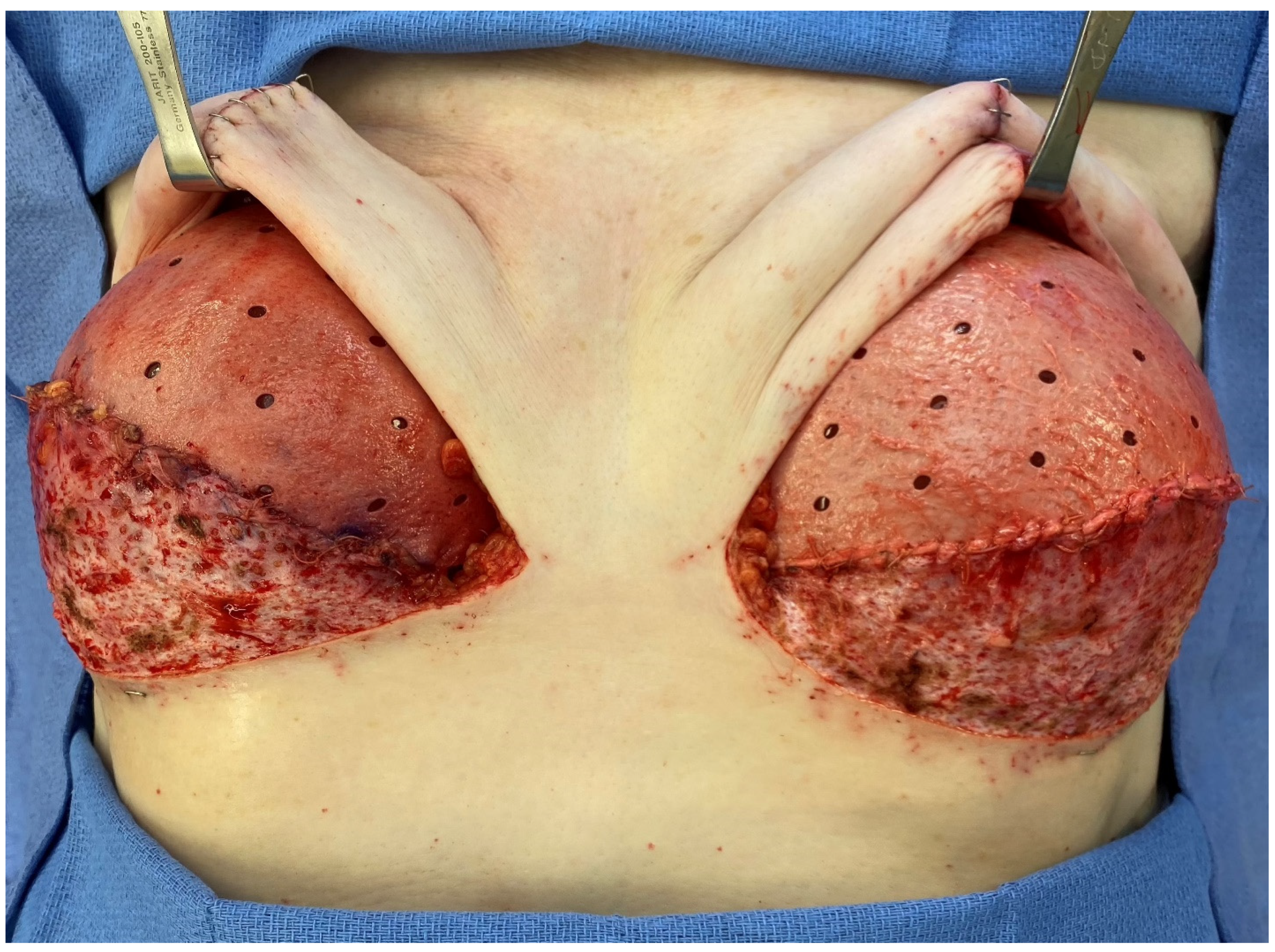Pre-Pectoral One-Stage Breast Reconstruction with Anterior Coverage Using Superior Anterior Biological Acellular Dermal Matrix (ADM) and Inferior Anterior Dermal Sling Support
Abstract
:1. Introduction
2. Case Report
3. Surgical Technique
4. Discussion
5. Conclusions
Author Contributions
Funding
Institutional Review Board Statement
Informed Consent Statement
Data Availability Statement
Conflicts of Interest
References
- Sisti, A.; Huayllani, M.T.; Boczar, D.; Restrepo, D.J.; Spaulding, A.C.; Emmanuel, G.; Bagaria, S.P.; McLaughlin, S.A.; Parker, A.S.; Forte, A.J. Breast cancer in women: A descriptive analysis of the national cancer database. Acta Bio Med. 2020, 91, 332–341. [Google Scholar]
- Sadeghi, P.; Aryan, N.; Sisti, A. Recent Advances in Implant-Based Breast Reconstruction. Plast. Reconstr. Surg. 2021, 147, 875e–876e. [Google Scholar] [CrossRef] [PubMed]
- Karadeniz Cakmak, G. Innovative Standards in Oncoplastic Breast Conserving Surgery: From Radical Mastectomy to Extreme Oncoplasty. Breast Care 2021, 16, 559–573. [Google Scholar] [CrossRef] [PubMed]
- La Padula, S.; Billon, R.; Schonauer, F.; D’Andrea, F.; Noel, W.; Belkacémi, Y.; Bosc, R.; Hersant, B.; Meningaud, J.P. Skin-reducing oncoplasty: A new concept and classification in breast cancer surgery. Ann. Chir. Plast. Esthet. 2018, 63, 285–293. [Google Scholar] [CrossRef] [PubMed]
- Zucca-Matthes, G. Oncoplastic Breast Surgery Techniques for the General Surgeon. In Oncoplastic Breast Surgery Techniques for the General Surgeon; Klimberg, V.S., Kovacs, T., Rubio, I.T., Eds.; Springer International Publishing: Cham, Switzerland, 2020; pp. 613–623. [Google Scholar]
- Petrie, K.; Cox, C.T.; Becker, B.C.; MacKay, B.J. Clinical applications of acellular dermal matrices: A review. Scars Burn. Health 2022, 8, 20595131211038313. [Google Scholar] [CrossRef] [PubMed]
- Nahabedian, M.Y. Current Approaches to Prepectoral Breast Reconstruction. Plast. Reconstr. Surg. 2018, 142, 871–880. [Google Scholar] [CrossRef] [PubMed]
- Cuomo, R. Submuscular and Pre-Pectoral ADM Assisted Immediate Breast Reconstruction: A Literature Review. Medicina 2020, 56, 256. [Google Scholar] [CrossRef]
- Caputo, G.G.; Marchetti, A.; Pozza, E.D.; Vigato, E.; Domenici, L.; Cigna, E.; Governa, M. Skin-Reduction Breast Reconstructions with Prepectoral Implant. Plast. Reconstr. Surg. 2016, 137, 1702–1705. [Google Scholar] [CrossRef]
- Thuman, J.; Freitas, A.M.; Schaeffer, C.; Campbell, C.A. Prepectoral Wise-Pattern Staged Implant-Based Breast Reconstruction for Obese or Ptotic Patients. Ann. Plast. Surg. 2019, 82, S404–S409. [Google Scholar] [CrossRef]
- Salgarello, M.; Visconti, G.; Barone-Adesi, L.; Franceschini, G.; Magno, S.; Terribile, D.; Masetti, R. Inverted-T skin-reducing mastectomy with immediate implant reconstruction using the submuscular-subfascial pocket. Plast. Reconstr. Surg. 2012, 130, 31–41. [Google Scholar] [CrossRef]
- Cuomo, R.; Giardino, F.R.; Neri, A.; Nisi, G.; Brandi, C.; Zerini, I.; Jingjian, H.; Grimaldi, L. Optimization of Prepectoral Breast Reconstruction. Breast Care 2020, 16, 36–42. [Google Scholar] [CrossRef] [PubMed]
- Bindingnavele, V.; Gaon, M.; Ota, K.S.; Kulber, D.A.; Lee, D.-J. Use of acellular cadaveric dermis and tissue expansion in postmastectomy breast reconstruction. J. Plast. Reconstr. Aesthetic Surg. 2007, 60, 1214–1218. [Google Scholar] [CrossRef]
- Nahabedian, M.Y. Acellular dermal matrices in primary breast reconstruction: Principles, concepts, and indications. Plast. Reconstr. Surg. 2012, 130, 44s–53s. [Google Scholar] [CrossRef] [PubMed]
- Kim, I.-K.; Park, S.O.; Chang, H.; Jin, U.S. Inhibition Mechanism of Acellular Dermal Matrix on Capsule Formation in Expander-Implant Breast Reconstruction after Postmastectomy Radiotherapy. Ann. Surg. Oncol. 2018, 25, 2279–2287. [Google Scholar] [CrossRef] [PubMed]
- Berna, G.; Cawthorn, S.J.; Papaccio, G.; Balestrieri, N. Evaluation of a novel breast reconstruction technique using the Braxon® acellular dermal matrix: A new muscle-sparing breast reconstruction. ANZ J. Surg. 2014, 87, 493–498. [Google Scholar] [CrossRef] [PubMed]
- Cattelani, L.; Polotto, S.; Arcuri, M.F.; Pedrazzi, G.; Linguadoca, C.; Bonati, E. One-Step Prepectoral Breast Reconstruction With Dermal Matrix–Covered Implant Compared to Submuscular Implantation: Functional and Cost Evaluation. Clin. Breast Cancer 2018, 18, e703–e711. [Google Scholar] [CrossRef] [PubMed]
- Kankam, H.; Hourston, G.; Forouhi, P.; Di Candia, M.; Wishart, G.; Malata, C. Combination of acellular dermal matrix with a de-epithelialised dermal flap during skin-reducing mastectomy and immediate breast reconstruction. Ann. R. Coll. Surg. Engl. 2018, 100, e197–e202. [Google Scholar] [CrossRef] [PubMed]
- Maruccia, M.; Elia, R.; Gurrado, A.; Moschetta, M.; Nacchiero, E.; Bolletta, A.; Testini, M.; Giudice, G. Skin-Reducing Mastectomy and Pre-pectoral Breast Reconstruction in Large Ptotic Breasts. Aesthetic Plast. Surg. 2020, 44, 664–672. [Google Scholar] [CrossRef] [PubMed]






Publisher’s Note: MDPI stays neutral with regard to jurisdictional claims in published maps and institutional affiliations. |
© 2022 by the authors. Licensee MDPI, Basel, Switzerland. This article is an open access article distributed under the terms and conditions of the Creative Commons Attribution (CC BY) license (https://creativecommons.org/licenses/by/4.0/).
Share and Cite
Sisti, A.; Sadeghi, P.; Cuomo, R.; Alvarez, S.M. Pre-Pectoral One-Stage Breast Reconstruction with Anterior Coverage Using Superior Anterior Biological Acellular Dermal Matrix (ADM) and Inferior Anterior Dermal Sling Support. Medicina 2022, 58, 992. https://doi.org/10.3390/medicina58080992
Sisti A, Sadeghi P, Cuomo R, Alvarez SM. Pre-Pectoral One-Stage Breast Reconstruction with Anterior Coverage Using Superior Anterior Biological Acellular Dermal Matrix (ADM) and Inferior Anterior Dermal Sling Support. Medicina. 2022; 58(8):992. https://doi.org/10.3390/medicina58080992
Chicago/Turabian StyleSisti, Andrea, Payam Sadeghi, Roberto Cuomo, and Sonia M. Alvarez. 2022. "Pre-Pectoral One-Stage Breast Reconstruction with Anterior Coverage Using Superior Anterior Biological Acellular Dermal Matrix (ADM) and Inferior Anterior Dermal Sling Support" Medicina 58, no. 8: 992. https://doi.org/10.3390/medicina58080992
APA StyleSisti, A., Sadeghi, P., Cuomo, R., & Alvarez, S. M. (2022). Pre-Pectoral One-Stage Breast Reconstruction with Anterior Coverage Using Superior Anterior Biological Acellular Dermal Matrix (ADM) and Inferior Anterior Dermal Sling Support. Medicina, 58(8), 992. https://doi.org/10.3390/medicina58080992








